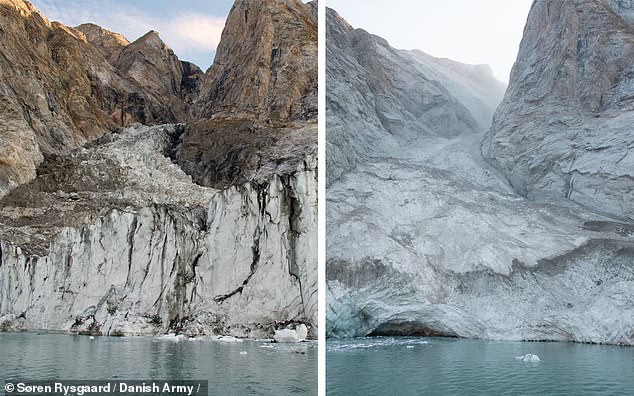Massive landslide triggers 200-meter-high ‘mega-tsunami’ and causes earth to shake for 9 DAYS

After a mountaintop in Greenland collapsed into the sea, a skyscraper-sized “megatsunami” shook the Earth for nine days, leaving scientists around the world baffled.
No one was injured in the landslide or the subsequent tsunami, but the 208-meter-high wave destroyed about $200,000 worth of infrastructure at an abandoned research station on Ella Island.
Furthermore, the events occurred near a route frequently traveled by cruise ships, which could have resulted in tragedy if one had been sailing at the time.
Until now, no one knew what caused the mysterious seismic activity that began in September 2023 and lasted more than a week. It took an international team of scientists to trace it back to the landslide.
“When we started this scientific adventure, everyone was baffled and no one had the faintest idea what was causing this signal,” said Kristian Svennevig, lead author of the study and a geologist at the Geological Survey of Denmark and Greenland.

Before and after the massive landslide that dumped 33 million cubic meters of ice and rock into a Greenland fjord, triggering a 200-meter-high “megatsunami” that shook the earth for nine days
Svennevig and her colleagues are now convinced that climate change triggered the landslide. The glacier at the foot of the mountain has melted, destabilizing enough ice and rock to fill 10,000 Olympic swimming pools.
And as rising global temperatures melt polar regions, devastating landslides like this one could become more common.
The research team published their findings today in the journal Science.
When seismic monitoring networks first detected the activity, scientists were baffled for two reasons.
First, the signal was spread much more widely than the typical tight blips an earthquake produces on a seismograph (a device used to record ground shaking).
“The tremors varied with an interval of 92 seconds between peaks, too slow for humans to detect,” said a statement from the University of California, San Diego, one of the institutions that worked on the study.
Second, the signal remained strong for nine days. Typical seismic events decay much more quickly — the average earthquake lasts only seconds to minutes.
Scientists around the world quickly set to work to unravel this strange signal.

Climate change has created the conditions for this landslide by melting a glacier at the base of the mountain, destabilizing enough ice and rock to fill 10,000 Olympic swimming pools

The megatsunami destroyed about $200,000 worth of infrastructure at an unoccupied research station on Ella Island, but no one was injured
Online discussions eventually turned up reports of a massive landslide that occurred on September 16, 2023, on a mountain overlooking a remote fjord in eastern Greenland.
To determine whether the landslide was related to the mysterious quake, a research team led by Svennevig digitally reconstructed the landslide and the resulting tremors.
They did this using a combination of seismic recordings from around the world, field measurements, satellite images and computer simulations.
The researchers also used supercomputers to simulate the 208-meter-high megatsunami caused by the 33 million cubic meters of rock and ice that crashed into the fjord.
The waves were sloshing back and forth in the fjord, a phenomenon known as seiche. The researchers concluded that this sloshing was the cause of the nine-day streak of seismic activity that shook the Earth last year.
“Ultimately, it took numerous geophysical observations and numerical models from researchers in many countries to put the puzzle together and get a complete picture of what happened,” said co-author Robert Anthony, a geophysicist with the United States Geological Survey’s Earthquake Hazards Program, in a statement.
The researchers said the findings highlight the “complex, cascading hazards” posed by the impact of climate change on the Earth’s polar regions.
“Climate change is changing the way things work on Earth and can trigger unusual events,” co-author Alice Gabriel, a seismologist at the University of California, San Diego, said in a statement.
Fortunately, there were no people around when the massive landslide and subsequent tsunami occurred. But this incident highlights the importance of monitoring polar regions as climate change accelerates.




